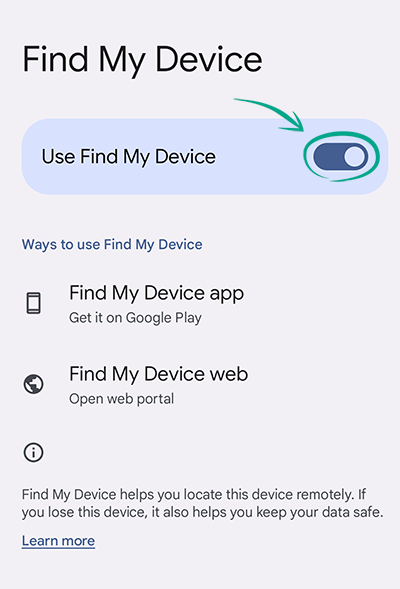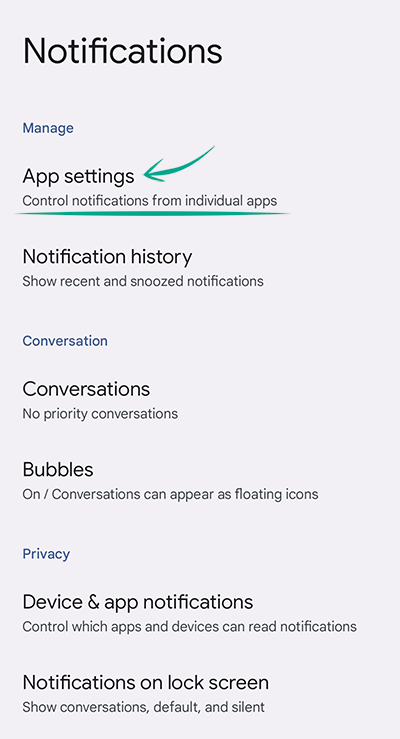Protect your Google account
open allMost Android devices are linked to a Google account, so the security of your data directly depends on the security of this account. Therefore, you are advised to check the settings of your Google account in addition to your Android settings.
Settings may differ on your specific device.
Android is an open-source operating system. Device manufacturers may make significant changes to it, including modifications to the interface. Therefore, the appearance of Android may significantly differ on devices from various manufacturers. For example, the menu may contain more or fewer menu items, they may be named differently, or may be missing entirely. The following instructions are applicable to Android with the standard Google Shell (also known as "Stock Android"). This operating system version can be found on Pixel smartphones and on Android One devices. If you have the shell of a third-party developer installed, you will find the relevant settings in the equivalent sections of menus but with possibly different names.
How to hide your data from prying eyes
open allWhat for: So that only you can unlock your device.
The safest way to unlock your screen is by using a password or a fingerprint scanner. A PIN code is easier to crack because it contains only numbers. A secret pattern is too easy to observe and remember. Finally, a facial recognition system can be deceived by a photo or 3D mask.
- Use a strong password that meets the following criteria:
- Is at least 8 characters long;
- Contains lowercase and uppercase letters, numbers, and special characters ($, @, etc.);
- Is not too simple, such as 12345678 or qwerty;
- Is not the same as any of your other passwords, including for your Google account;
- Is not an actual word or easy-to-guess phrase;
- Does not consist of information that strangers could easily find out (your name, date of birth, pet's name, and so forth — or those of your friends or relatives).
To set a password:
- Open Settings;
- Go to the Security & privacy section;
- Tap Device lock under Settings;
- Select Screen lock;
- Tap Password;

- Enter a strong password and tap Next;
- Enter your password again and tap Confirm;
- The system will suggest three options for displaying notifications on the lock screen:
- Show all notification content. This means you will see both the notification and the message text on the lock screen;
- Show sensitive content on unlocked screen only. You will see the notification from the app, but the text will be hidden. This is the recommended option;
- Don't show notifications. Notifications will be completely hidden on the lock screen.
You can change the notification option any time. To do so, follow these steps.
Please keep in mind that even if you are planning to unlock by fingerprint, you should first set a strong password. Your device provides the capability to sign in with a password or PIN code in case the fingerprint scanner malfunctions. A simple combination will be easy to crack if your phone ends up in the wrong hands.
To configure sign-in by fingerprint:
- Open Settings;
- Go to the Security & privacy section;
- Tap Device lock under Settings;
- Select Fingerprint Unlock;

- The system will first suggest choosing a backup login option: graphical key, PIN, or password. Select Password;
- Choose the way notifications will be displayed on the lock screen;
- Scroll to the bottom of the page that opens and tap Accept;
- Tap Start;
- Follow the on-screen directions to scan your fingerprint several times;
- Tap Done;
- You can add other fingerprints while you're at it by tapping Add a fingerprint or do it later.
How to keep your account from getting hacked
open allWhat for: To protect yourself against overly curious and malicious apps.
Your smartphone is protected by the Google Play Protect service by default. It scans all the apps that you download to your device regardless of its source. If an app is dangerous, conceals something from the user, or secretly collects private data, you will receive the appropriate notification. We recommend that you do not turn off this security tool. If you nonetheless have disabled it, you are advised to activate it:
- Open the Settings menu;
- Go to the Security & privacy section;
- Select App security; The Google Play app opens;

- Tap the gear icon in the upper right corner of the screen;
- Turn on Scan apps with Play Protect.
You can manually scan apps at any time. To do so, in the Play Protect section, tap Scan. Please note that the built-in app scanning service provides only the basic level of security. For best protection against threats, use a full-fledged anti-virus application for Android.
How to protect your data
open allWhat for: To find your device if it is lost or stolen.
This feature enables you to find your phone and lock it in case it is lost or stolen. It also lets you delete all data from your phone, call it, or contact the mobile service provider.
To enable the Find My Device feature:
- Open the Settings menu;
- Go to the Security section;
- Select Use Find My Device and enable the feature;

- If Location is turned off, you will see the message Turn on device location. Tap the warning text and activate location.
Please note that you will only be able to find your device if it is turned on, has an Internet connection, and is transmitting its location data.
Downside: Location services must always be enabled on your device. This means that your device will use up more battery, and your location information will be transmitted to Google.
How to take control of apps
open allWhat for: So that developers collect less information about you.
Apps often request more permissions than they require for their operation. Normally, this is because developers want to collect as much data from you as possible and use that data for advertising. Some applications may blatantly abuse these permissions. For example, they may send text messages, make phone calls, or take photos and videos without your knowledge. You should only grant these permissions if you are sure that they are absolutely necessary.
Fortunately, in the latest versions of Android, an app can be installed and started even without being granted all the permissions they request. For example, if a messenger requests permission to access your camera but you do not intend to send any photos or videos to your friends, you can deny this permission.
To check the permissions of apps and revoke unnecessary access:
- Open Settings;
- Go to the Security & privacy section;
- Select Privacy;
- Tap Permission manager;

- Select the relevant permission. To see the entire list, tap Additional permissions;
- Tap the app name and select Don't allow to revoke its access.

If you attempt to revoke a permission that an app requires to continue working properly, you will see a warning. Even in this case, you can still deny access if you are confident in your decision.
You can always grant an app any necessary permissions again if it fails to start or fails to support the features you need.
How to get rid of unwanted notifications and ads
open allWhat for: To keep your peace of mind.
Some apps may send you a large number of notifications that could be distracting and irritating. An endless flow of notifications could also cause you to easily miss something that is actually important.
You can disable certain types of notifications or completely block apps from sending them:
- Open the Settings menu;
- Go to the Notifications section;
- Tap App settings;

- In the list of apps, select the one that distracts you the most. You can use the Most frequent filter;
- If you want to completely block an app from sending notifications, deactivate the toggle for All notifications;
- If you want to block only certain notifications, deactivate the toggles next to the relevant events.
If you are irritated by notifications but do not know which app is sending them, you can view all the recent notifications and disable the unnecessary ones:
- Open the Settings menu;
- Go to the Notifications section.
Tap Notification history. You can configure notifications of specific apps directly from the notification itself. To do so, when you receive a notification:
- Swipe the screen from top to bottom;
- Tap and hold your finger on the notification that you want to configure;
- When the gear icon appears, tap it;
- If you want to completely turn off all notifications from the app, disable Allow notifications.




